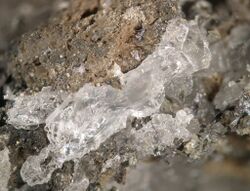Chemistry:Evenkite
| Evenkite | |
|---|---|
 Evenkite from Dubnik, Slovakia | |
| General | |
| Category | Organic mineral |
| Formula (repeating unit) | C24H50 |
| Strunz classification | 10.BA.50 |
| Crystal system | Orthorhombic |
| Crystal class | Dipyramidal (mmm) H-M symbol: (2/m 2/m 2/m) |
| Space group | Pbcm |
| Unit cell | a = 7.47, b = 4.98, c = 65.85 [Å]; Z = 4 |
| Identification | |
| Color | Colorless or pale yellow |
| Crystal habit | Tabular pseudohexagonal crystals, granular, disseminated |
| Twinning | Polysynthetic |
| Cleavage | {001} Perfect |
| Mohs scale hardness | 1 |
| |re|er}} | Waxy |
| Diaphaneity | Transparent |
| Specific gravity | 0.87 |
| Optical properties | Biaxial (+) |
| Refractive index | nα = 1.504 nβ = 1.504 nγ = 1.553 |
| Birefringence | δ = 0.049 |
| References | [1][2][3][4][5][6][7][8][9] |
Evenkite is a rare hydrocarbon mineral with formula C24H50; specifically, H3C–(CH2)22–CH3, the alkane n-tetracosane. [8] It occurs as very soft (Mohs hardness 1) transparent crystals, colorless to yellow, with a waxy luster. The softness is a characteristic of crystalline long-chain alkanes, which are the main constituents of paraffin wax.[9]
Evenkite one of very few minerals that consist of crystalline hydrocarbons,[7][5] which include carpathite (pure crystalline coronene, a polyaromatic hydrocarbon).[11] It is also one of the few non-porous minerals that floats on water. It has been claimed to be the same as hatchettite.[12]
History and geologic occurrence
Evenkite was first described in 1953 by A. V. Shropyshev, as found in the Khavokiperskiye deposit, Lower Tunguska River, Evenkiysky District, Siberia, Russia , where it occurs inside geodes and vugs in a quartz vein in welded tuff.[6] It was named after the district.[2] It has also been reported from the Hautes-Alpes region in France and the Slanské and Vihorlat mountains of Slovakia.[1]
Evenkite appears as flaky wax partials on top of the quartz crystals.[4] Associated minerals include quartz, chalcedony, pyrite, pyrrhotite, sphalerite, galena, chalcopyrite and calcite.[3]
Evenkite was the last part of the geode to form.[4] It is believed to have resulted from thermal cracking of the organic matter (manly marine plants) that where trapped in the septarian concretions during the Jurassic burial, as the buried sediments were subjected to high pressure and temperatures.[5] The French Alps region received a lot of geological uplift after the Jurassic burial.[4]
See also
References
- ↑ 1.0 1.1 Mindat.org
- ↑ 2.0 2.1 Webmineral data
- ↑ 3.0 3.1 Handbook of Mineralogy
- ↑ 4.0 4.1 4.2 4.3 Spangenberg, J.E. and Meisser, N. "Geochemistry of the organic mineral evenkite in septarian concretions in the Oxfordian marls of the French Alps". Mineralogical Magazine, 1998, p.1436-1437.
- ↑ 5.0 5.1 5.2 Jechlicka, J., Villar, S., and Edwards, G.M. "Raman spectroscopy of natural accumulated paraffins from rocks: Evenkite, ozokerite, and hatchtine". Spectrochimica Act, 2007, p.1143-1148.
- ↑ 6.0 6.1 Skropyshev, A.V. "On Paraffin from a Base Metal Vein". Doklady Acad, 1953, P.717-719.
- ↑ 7.0 7.1 Platonova, N.V. and Kotel'nikova, E.N. "Synthesis of Organic Mineral Evenkite". Geology of Ore Deposits, 2006, p.87-91.
- ↑ 8.0 8.1 Kotel'nikova, E.N., Platonova, N.V., and Filatov, G.M. "Identification of Biogenic Paraffins and Their Thermal Phase Transitions". Geology of Ore Deposits, 2006, p.607-709.
- ↑ 9.0 9.1 Pilonen, P.C. and Ercit, T.S. "New Mineral Names". American Mineralogist, 2005, p.1466-1469.
- ↑ Warr, L.N. (2021). "IMA–CNMNC approved mineral symbols". Mineralogical Magazine 85 (3): 291–320. doi:10.1180/mgm.2021.43. Bibcode: 2021MinM...85..291W.
- ↑ Takuya Echigo, Mitsuyoshi Kimata, and Teruyuki Maruoka (2007): "Crystal-chemical and carbon-isotopic characteristics of karpatite (C24H12) from the Picacho Peak Area, San Benito County, California: Evidences for the hydrothermal formation". American Mineralogist, volume 92, issues 8-9, pages 1262–1269. Note: the name should be spelled "carpathite". doi:10.2138/am.2007.2509
- ↑ J. E. Spangenberg and N. Meisser (2000): ""Hatchettite and Evenkite - two mineral names for the same natural crystalline paraffinic vax[isotope ratio study]". Paper EDB-00:118740 Abstracts of the 5th Isotope Workshop of European Society for Isotope Research, pages 188-191. ISBN 83-912388-8-1
 |

